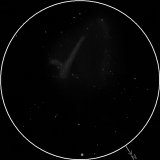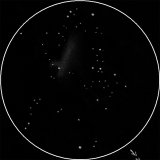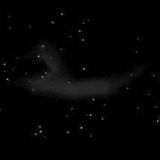
| MESSIER 17 |
|---|
RA: |
18h 20m 48s |
|
DEC: |
-16° 11' 00'' |
|
Type: |
Emission nebula |
|
NGC: |
6618 |
|
Magnitude: |
6.00 |
|
Surface brightness : |
11.20 |
|
Apparent dimensions : |
11'x11' |
|
Distance: |
5,000 ly |
|
Discovered by Philippe Loys de Chéseaux in 1745-46. The Omega Nebula M17, also called the Swan Nebula, the Horseshoe Nebula, or (especially on the southern hemisphere) the Lobster Nebula, is a region of star formation and shines by excited emission, caused by the higher energy radiation of young stars. Unlike in many other emission nebulae, however, these stars are not obvious in optical images, but hidden in the nebula. Star formation is either still active in this nebula, or ceased very recently. A small cluster of about 35 bright but obscurred stars seems to be imbedded in the nebulosity. The color of the Omega Nebula is reddish, with some graduation to pink. This color comes from the hot hydrogen gas which is excited to shine by the hottest stars which have just formed within the nebula. However, the brightest region is actually of white color, not overexposed as one might think. This phenomenon is apparently a result of a mixture of emission light from the hottest gas, together with reflections of the bright star light from the dust in this region. The nebula contains a large amount of dark obscuring material, which is obvious in its remarkable features. This matter has been heated by the hidden young stars, and shines brightly in infrared light. The mass of the gas has been estimated to amount about 800 times that of the Sun, enough for forming a conspicuous cluster, and a good deal more than that of the Orion nebula M42. While the bright nebula seems to be roughly 15 light years in extension, the total gaseous cloud, including low-luminosity material, seems to extend to at least 40 light years. Distance estimates are spread over a wide range, but modern values are between 5,000 and 6,000 light years, thus little less than that of its apparent neighbor, M16 with the Eagle nebula - apparently, these two star forming regions are indeed close together, in the same spiral arm (the Sagittarius or Sagittarius-Carina arm) of the Milky Way galaxy, and perhaps part of the same giant complex of cosmic clouds of interstellar matter. As for many diffuse nebulae, the overall brightness of this object is difficult to estimate, and is given discordantly in the sources. While older sources give estimates around 7.0 magnitudes, probably because these were performed at northern observatories, modern compilations list its visual magnitude brighter. The Omega or Swan Nebula M17 can be found quite easily, and similar and simultaneously to its apparent neighbor, M16. The first way to find it is locating the white giant star Gamma Scuti, of magnitude 4.70 and spectral type A2 III, e.g. from Altair (Alpha Aquilae) via Delta and Lambda Aql; M16 is slightly more than 2 degrees to the southwest of this star. Alternatively, in particular with a pair of binoculars, locate star cloud M24 and move northward via a pair of stars of 6th and 7th mag in the north-eastern edge of M24, followed by small open cluster M18 1deg north, and M17 another 1deg to the north. Under very favorable conditions, M17 is just visible to the naked eye at its apparent visual brightness of 6.0 magnitudes. |
||
OTHER SKETCHES |
|||||
 |
 |
||||
Messier 17 with UHC filter |
Messier 17 |
||||
VEDRAN VRHOVAC© 2006.-2007. |
